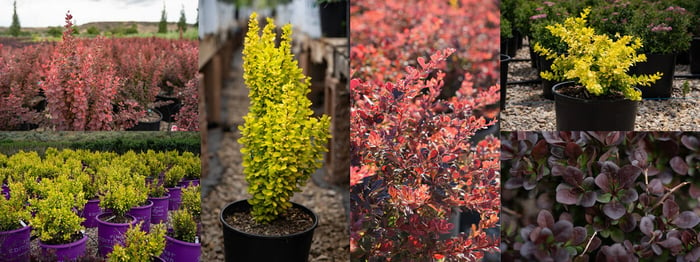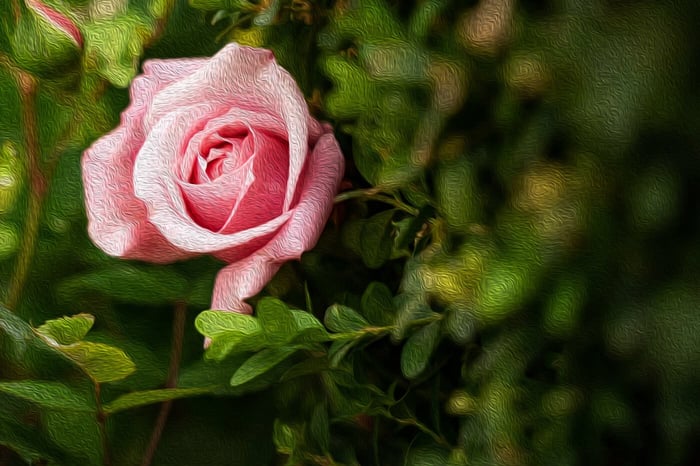The versatile barberry bush could be the key to artistic expression in your landscape.

Mother Nature creates her own perfect art without any help from us.
The driving force behind art has been to mimic the beauty of nature. Artists have attempted this through photo-realistic paintings, detailed sculptures, or even loose patches of color carefully placed to create contrast, composition, or visual interest. The same natural elements artists strive to mimic in their work such as, light, shadow, texture, color, shape, form, and contrast, will make your own landscape pop with life and beauty.

There’s a lot to consider when you’re designing your landscape, but if you focus on contrast, you’ll win the biggest part of the battle. As you consider contrast in your landscape, think of the contrast between complementary colors, light and dark, large and small, columnar and broad, and compact and loose. Placing complementary elements near each other will make both plants pop, and incorporating varying textures in your yard will make your plants stand out against each other as they catch the light and your attention. Remember, also, that flowers are usually short-lived compared to foliage. If you can find these elements in the foliage of your plants, your landscape will have longer-lasting appeal.

Did you know that there is one family of shrubs that checks most of those boxes? Meet Berberis thunbergii, better known as Barberry bushes. You could work wonders in your landscape simply by planting a variety of these shrubs in your yard. They are available in a wide array of colors, sizes and shapes, and they’re perfectly suited for our region. They tolerate our extreme temperatures, can handle our various soil structures, manage water from any source, and they’re deer resistant. All barberry bushes have barbs or thorns, but they’re quite easy to manage with gloves.
If we tried to focus on each one of these stunning shrubs, we would sound like a broken record pretty quickly. So we’ll introduce you to a few of them and encourage you to search the rest on our website.
Orange Rocket
Berberis thunbergii 'Orange Rocket' PP18411 Upright Orange Barberry
This compact, upright growing shrub is great for smaller spaces because it will reach up to 4 feet tall but only 2 feet wide. New foliage erupts as a vibrant coral-tinted orange in spring before fading to burgundy for summer. Leaves shaded from direct sun will be green at maturity. Autumn brings a flush of brilliant ruby red.
Golden Rocket
Berberis thunbergii 'Golden Rocket®' PP18626 Upright Yellow Barberry
This narrow-growing shrub stands out in your garden with bright yellow foliage and coral-colored stems. Pale yellow flowers appear in the spring and are followed by bright red berries in the fall. It will reach 5 feet tall and 2 feet wide.
Orange Torch
Berberis thunbergii 'Orange Torch' Upright Orange Barberry
We really love this upright, low maintenance shrub. It works well as a hedge, accent, or border. It will grow 3 to 4 feet tall and 2 to 3 feet wide. You plant this shrub for its color. New growth starts out vibrant orange and changes to chartreuse during summer. Foliage is accented with red stems and bits of orange on the chartreuse leaves. Cooler weather turns most of the leaves to orange and red. It’s almost like watching a fire flicker slowly throughout the growing season. If you don't find them on our site, keep checking. They move quickly!
Concorde
Berberis thunbergii atro 'Concorde' Dwarf Red-Purple Barberry
If you’re looking for dark, nearly black foliage, you’ll find it here. Concorde is a dwarf, deciduous shrub with burgundy foliage and an excellent habit that requires virtually no pruning. Small yellow flowers in the spring turn into red berries in the fall and winter. It will reach 2 feet tall and up to 3 feet wide.
Limoncello
Berberis thunbergii 'BailErin' First Editions® Limoncello™ Dwarf Yellow Barberry
This barberry will catch your eye with bright yellow-green leaves tinted with red around the margins. It has a very compact mounding habit and will grow up to 3 feet tall and wide. Leaves turn orange and red in the fall.
Rose Glow
Berberis thunbergii atro 'Rose Glow' Red-Pink Barberry
You’ll appreciate this dense, upright, deciduous shrub for the way it catches the light. New foliage is rose-pink mottled with reddish purple splotches, turning to solid deep reddish purple. Fall brings an orange-red color to the leaves and bright red berries that persist through winter. It will reach 4 to 5 feet tall and 4 feet wide.
Crimson Pygmy Dwarf Red
Berberis thunbergii atro nana 'Crimson Pygmy' Dwarf Red Barberry
This is a fun little barberry that will reach 2 feet tall by 3 feet wide. It features dark red foliage throughout the summer that changes to orange, red and yellow in the fall months. The leaves hold their color well in full sun.
Royal Burgundy Dwarf Red-Purple
Berberis thunbergii atro 'Royal Burgundy' Dwarf Red-Purple Barberry
A uniform, dense, low mounded growth habit makes this shrub incredibly low-maintenance. Similar to 'Crimson Pygmy', but with richer red purple foliage, which holds well all summer, and a slightly smaller growth habit. It maintains a compact 2 foot by 2 foot form.
Aurea Nana Dwarf Yellow Barberry
Berberis thunbergii 'Aurea Nana' Dwarf Yellow Barberry
This is a knockout in the landscape, with its small, bright yellow leaves. It’s a small, dense, deciduous shrub that doesn't fruit or flower too heavily, and it grows 3 to 4 feet tall and wide.













